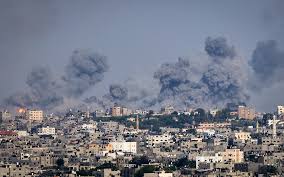By Prasad Nallapati*
Like every new year’s day, we welcomed the year 2025 wishing ourselves much better future than the previous one.
What’s really in store? Will it be truly a better one or more of the same? Let’s look at the global security and politico-economic scenario to get some clues to what’s going to come.
Donald Trump’s Presidency in the USA is perhaps the single most significant development that would shake up the world in more than one way, leaving no corner unaffected.
There are still a couple of weeks before he ascends to power, but his threats of new tariffs on imports and security demands have already rattled many world leaders who are rushing to make adjustments to new challenges. However, resistance may soon build up to his diktats creating fissures even with own allies.
Conflict Zones – Europe
Long drawn wars in Europe and West Asia have taken a serious toll on global trade and security during the past two years and are expected to end soon in the current form as priorities change in Washington DC.
Russian forces marched into Ukraine in February 2022 hoping it to be quick walkover. Biden Administration’s determination to grab the opportunity to weaken President Putin and force a regime change in Moscow, however, dragged the European war with no sign of either side winning it outright.
Trump has different priorities in Europe and has often said that the war would have ended long ago under his watch. His Republican Party in the Congress has opposed massive military aid to Ukraine. The new US President is expected to call for an immediate ceasefire and negotiations to end the war.
President Zelensky is, however, likely to resist the ceasefire call but has limited options with no fresh military supplies coming up. It’s an advantage for Russia as it is in control of several areas of Ukraine.
West Asia
Hamas’ miscalculated October ’23 military challenge to Israel has not only decapitated its entire leadership, ending all Palestinian resistance in the near term, but also effectively demolished entire force structures of Iran and its `axis of resistance’.
What remains of the Hizbollah, the Shia militia in Lebanon, is a skeletal body which is in no position to challenge Israel in the foreseeable future. Iran’s own military defenses are thoroughly exposed making it incapable of flexing its muscles. The Houthis in Yemen are now at receiving end and may soon lose their ability to threaten Red Sea shipping.
Iran has also lost Syria to Turkey-backed Islamist groups led by Hayat Tahrir al Sham (HTS), formerly associated with terrorist groups, ISIS and Al Qaida.
Turkey is preparing to set up a buffer zone on the Syrian side of its border and disarm the US-backed Kurdish People’s Protection Unit (YPG), which it considers an extension of the Kurdistan Workers’ Party (PKK) that is waging an insurgency in Turkey.
YPG, however, is the only effective force in Syria that kept the ISIS under check.
Israel has set up its own buffer zone occupying Syrian side of the Golan Heights to neutralize any Islamist threats. Prime Minister Netanyahu has not done yet and demanded the US a free hand to mop up any remaining vestiges of resistance.
Trump agreed but wanted the wars to end before his inauguration on January 20.
But, will they end?
Israel may have effectively silenced the Hamas and the Hezbollah, but a new potent terrorist threat is lurking in the shadows right across the borders.
Abu Mohammed al-Julani, the new leader of Syria, is professing close relations with the US and Israel, but can he be trusted in view of his earlier links to the ISIS and the Al Qaida.
President Recep Erdogan of Turkey, the real force behind the Syrian regime, is no friend of Israel and has indicated that his next target is Al Aqsa mosque in Jerusalem, exposing his Islamist core.
Besides, Syria is not a settled issue as yet. Resistance is building up against the ruling Islamist HTS from sectarian groups, and Iran’s Revolutionary Guard Corps (IRGC) is putting together a counter-revolutionary force to destabilize the Turkey-backed regime.
Turkey’s resolve to dismantle the YPG is relieving pressure on the ISIS which is trying to reemerge, adding new challenges to Syria and beyond.
China Testing Trump on Taiwan
In East Asia, China is trying to test Trump administration’s resolve through increased military drills around Taiwan straits and South China Sea.
In his New Year’s message, President Xi Jinping said China’s “reunification” with Taiwan is inevitable, and that people on both sides “should be bound by a common sense of purpose and share in the glory of the rejuvenation of the Chinese nation.”
China has deployed massive naval forces around Taiwan last month claiming that it has the right to regulate the straits. It has conducted two rounds of war games around the island state.
China has also been building pressure on the Philippines, another American ally in the region, with its coast guard harassing the Philippine vessels in disputed waters of the Iroquois reef in the Spratly Islands of the South China Sea.
Indian Sub-continent
While Pakistan continues to face political and economic instability, Bangladesh appears to be increasingly slipping into the hands of Islamist forces, inimical to India’s interests. Myanmar is on the cusp of Balkanization with its troubles spilling into Indian border states of Manipur and Nagaland, creating serious security issues there.
The Biden administration has had a direct involvement in these sub-continental conflicts creating complications for India. Their role in the dismissal of the Imran Khan government is well documented. Some former intelligence operatives are reported to be actively aiding tribal groups in Myanmar and Indian North-eastern states.
Washington DC is not hiding their support to the new Bangladeshi dispensation, oblivious of the dangers of giving new lease of life to Islamist radical groups. Pakistan army, for the first time since the break up of the country, will be training Bangladesh’s military forces. Regular shipping activities between the two countries resumed, which was earlier suspended as Pakistani ships were involved in illegal supply of arms to Indian insurgent groups.
President Trump is expected to have very limited attention to these areas and India will have to deal with these uncertainties on its own. The Modi government has its work cut out in 2025 as all border areas are alive again threatening stability in the region.
Economy and Trade Wars
International organizations, like the World Bank and OECD, project persistent global economic uncertainty extending into 2025 despite resilient growth prospects across the regions.
The Goldman Sachs forecasts the US outperforming expectations while the euro area lags behind amid fresh tariffs that are anticipated from the Trump administration. Worldwide GDP is forecast to expand 2.7% on an annual average basis while that of the US at 2.5% in 2025. The euro area economy is expected to expand only at 0.8%.
India is the shining star with its GDP projected nearly at 7% for next two years, followed by Indonesia at 5%.
Inflation has declined towards central bank targets but intensification of the ongoing conflicts in West Asia may continue to disrupt energy markets impacting confidence and growth.
Rising tensions over tariffs risk hampering growth in global trade. Trump declared massive hikes in tariffs on goods coming from Mexico, Canada and China starting on the first day of his administration. India is not out of his sight as he vows reciprocal tariffs on it as well. Several others including European allies, South Korea, and Vietnam are on the firing line.
Thus, this year is also going to be as demanding as the previous one with many of the current challenges and uncertainties remaining unresolved while many more getting added to already complicated geo-political atmospherics.
(*Prasad Nallapati is President of the Hyderabad-based think-tank, “Deccan Council for Strategic Studies,” and former Additional Secretary in the Cabinet Secretariat, Govt of India)




